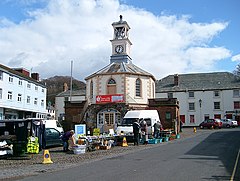Brampton, Cumberland
| Brampton | |
|---|---|
 The market place in Brampton in 2008 |
|
| Brampton shown within Cumbria | |
| Population | 4,627 (2011) |
| OS grid reference | NY530609 |
| Civil parish |
|
| District | |
| Shire county | |
| Region | |
| Country | England |
| Sovereign state | United Kingdom |
| Post town | BRAMPTON |
| Postcode district | CA8 |
| Dialling code | 016977 / 01697 |
| Police | Cumbria |
| Fire | Cumbria |
| Ambulance | North West |
| EU Parliament | North West England |
| UK Parliament | |
Brampton is a small market town, civil parish and electoral ward within the City of Carlisle district of Cumbria, England, about 9 miles (14 km) east of Carlisle and 2 miles (3.2 km) south of Hadrian's Wall. Historically part of Cumberland, it is situated off the A69 road which bypasses it. Brampton railway station, on the Newcastle and Carlisle Railway, is about a mile outside the town, near the hamlet of Milton.
St Martin's Church is famous as the only church designed by the Pre-Raphaelite architect Philip Webb, and contains one of the most exquisite sets of stained glass windows designed by Sir Edward Burne-Jones, and executed in the William Morris studio.
The town was founded in the 7th century as an Anglian settlement.
Brampton was granted a Market Charter in 1252 by King Henry III, and became a market town as a result.
During the Jacobite rising of 1745, Charles Edward Stuart stayed in the town for one night, marked by a plaque on the wall of the building (a shoe shop) currently occupying the location; here he received the Mayor of Carlisle who had been summoned to Brampton to surrender the city to the Young Pretender. The Capon Tree Monument, to the south of the town centre, commemorates the 1746 hanging of six Jacobites from the branches of the Capon Tree, Brampton's hitherto traditional trysting place.
...
Wikipedia

